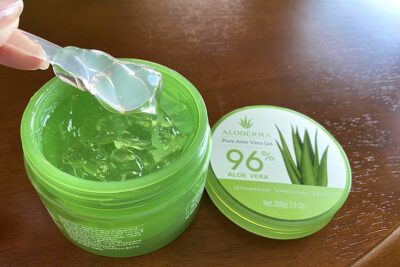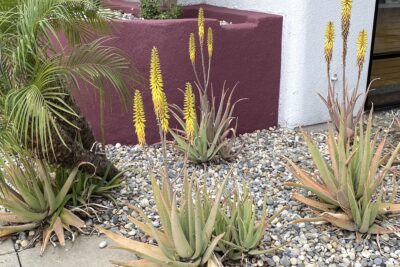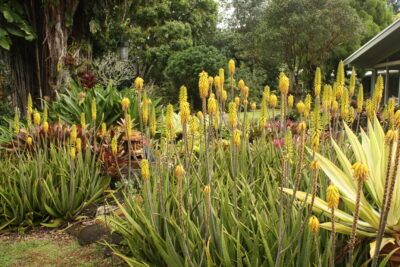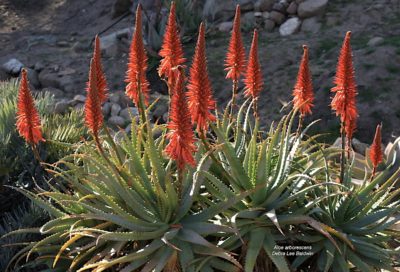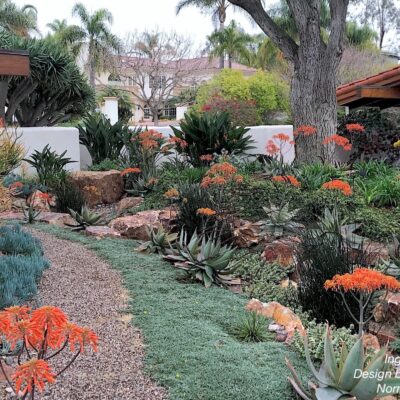Pam and Tim Jara's back yard in a San Diego residential development is a marvel of space planning. In it are seven distinct living areas: spa, bar-barbecue, dining, fireplace, vegetable garden, bonsai-mosaic garden, and fountain-aeonium garden.
There are even more if you include the succulent-filled front yard (with its tough and intriguing lawn alternative); cozy benches in garden nooks; a semi-shaded patio garden; and a nicely hidden utility area.
Everywhere you look in the Jaras' back yard are inviting outdoor rooms. Here and in the video are Tim and Pam's tips and ideas for how anyone might maximize a standard back yard.
The Artist and Her Expediter
Pam's the artist-designer and succulent expert; Tim's the pruner-installer-builder. "He trusts my eye," Pam says. "He almost never disagrees with me."
Both know a thing or two about plants, having volunteered at the San Diego Botanic Garden for over a decade. Tim helps keep the SDBG's bamboo forest beautiful, and Pam spruces the Garden's famed life-sized topiary dancers and sea-themed succulent display.

Past a mosaic mandala in Pam's aeonium garden is a dymondia pathway. It's one of two tough ground covers that the couple have in their garden.
Recently retired from nursing, Pam now makes ceramics and mosaics to ornament her own outdoor spaces and to sell (via Pam's Garden Art). She is a protege of San Diego artist Marsha Rafter, whose artworks and garden you can see here on my site and on YouTube.
Garden evolution
In addition to masses of well-tended succulents and colorful art pieces, what I love (and envy) about Tim and Pam's garden is how each defined area flows into the next.
Fifteen years ago, nurseryman Tom Piergrossi (now living in Hawaii) helped with plant selection, notably melaleuca trees. These Tim prunes and trains to show their intriguing, angular branching structure.
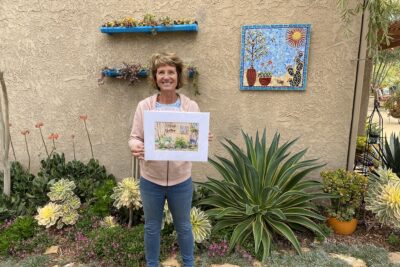
During the spring San Diego Horticultural Society garden tour, an artist painted a watercolor of Pam's garden.
"Very few of the original plants are left," Pam says. Tim adds that they switched to low-water succulents during Southern CA's drought years of 2010-2013.
In the video, Tim says that "paint used for soccer fields" works well for planning a garden's layout and pathways. One of several brands available is Rust-Oleum Marking Paint (affiliate link).
Series of Outdoor Rooms
The Jaras' back yard faces south, so it gets lots of sun and consequently needs shade---ideally dappled. Views are across a canyon and rooftops.
Spa
Set into an elevated corner, the spa has a low profile. Tim gave it a steplike deck to aid getting into the spa and also hide its mechanics while making them easily accessible.
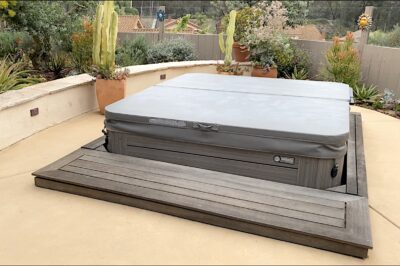
Tim nestled the spa to into the southwest corner of the garden.
Planted beds border a fence inset with panes of glass. These do make the garden airy and open, but have a downside: Depending on the angle of the sun during the year, the glass may magnify the sun's rays and fry plants. "I've learned which ones to cover," Pam says. Tim notes it would help to be able to rotate the angle of the glass.
Here and elsewhere, low stucco walls capped with flagstone define garden areas. They're also the right height for sitting.
Bar and Barbecue
With its pergola-style roof and granite countertops, the cocktails-and-barbecue area suggests an outdoor kitchen. However, its food-related aspects are limited to a built-in grill and an under-counter refrigerator, plus storage.
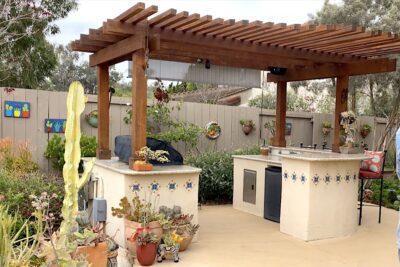
Pam and Tim's outdoor cocktail area and barbecue
Pam and Tim situated the high bar so guests can observe food and drinks as they're made, to enjoy the view beyond the spa, and to look down the broad path that meanders through the rest of the yard.
Bonsai/Mosaic Garden
Tim and Pam's plant expertise blend in a garden shaded by Melaleuca lanceolata trees. Pruned by Tim to show their quirky branching structure, the effect is of large, graceful bonsai with limbs that criss-cross.
Such switchback branches, at eye level and shaded by the trees' lacy canopy, serve as a jungle gym for family cat Rocket. When initially installed in 2007, the trees were 5-gallon shrubs. They're now 7 to 8 feet tall with canopies that knit together.

Tim trimmed the garden's melaleucas to resemble bonsai, and to thin their canopies to let in more light and not obstruct views.
Thriving in semishade below the melaleucas, all tended by Pam, are kalanchoes, echeverias, aloes, aeoniums, euphorbias, othonna and other succulents; as well as several kinds of plectranthus and pelargoniums.
The melaleuca area's focal point is a five-section totem that Pam made at Hacienda Mosaico in Puerta Vallarta, at a class taught by San Diego mosaic artist Marsha Rafter. (Marsha is perhaps best known for mandalas and commissions, including a free-standing paddle cactus. The design of the latter she also teaches; see an example made by Pam in the outdoor fireplace area).

Mosaic artist Pam Jara at Hacienda Mosaico in Puerto Vallarta, Mexico
"I made the base here," Pam says. Tim notes that totem sections stack on a vertical rod of PVC pipe.
Aeonium Garden and Fountain
Aeoniums, rosette succulents from the Canary Islands, grow effortlessly in San Diego's mild, maritime climate. A favorite of Pam's is Aeonium 'Sunburst', which (being in the arboreum species) gets tall and stays unbranched over time.
When 'Sunburst' elongates into bloom, "it's beautiful, but so sad," Pam says as she cuts a dying 3-foot specimen close to the ground. On the plus side, it'll look good in a tall vase for weeks, and because it'll live off stored moisture, doesn't need water.
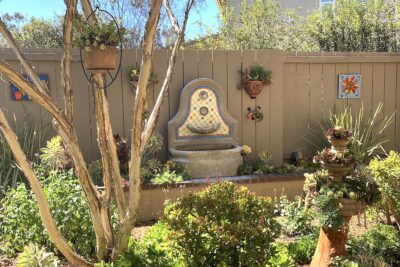
Wall fountain adjacent to Pam's aeonium garden
A splashing wall fountain in the aeonium garden enhances its ambience, attracts wild birds, and muffles neighborhood noise. In the same area is a three-tier dry fountain planted with succulents.
And speaking of fountains, there's yet another in a tall ceramic pot near the outdoor fireplace...
Fireplace sitting area
The Jaras angled their outdoor fireplace to better serve as a focal point. It's visible from much of the garden as well as from indoors.
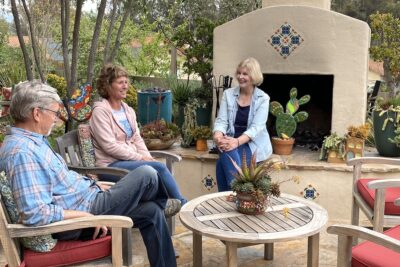
Tim and Pam (with me) in their garden's fireplace sitting area
Cushioned teak chairs and round coffee table create one of the garden's most inviting areas. Coral-colored outdoor fabric works with Pam's mosaics and complement the turquoise-blue fountain and inset Mexican tiles. With water that bubbles over rounded rocks, the fountain creates a soothing sound and is a hummingbird magnet.

Pam accessorizes garden areas with Talavera pottery from Mexico. This hanging pot holds burro tail sedum.
Outdoor dining table
An outdoor table shaded by a patio umbrella is steps from the home's kitchen, easily accessed through a pergola-covered patio.

View of outdoor dining area from the kitchen
In the patio's semishade, curving alongside the house, is a garden bed of bromeliads and variegated succulents. "They're so happy here," Pam says of the sun-sensitive plants.
Raised bed vegetable garden
The garden path ends in raised beds Tim built for herbs and vegetables. He's quick to point out that they're not getting enough sun, which he'll take care of by pruning a nearby tree. "A garden's never finished," Pam notes.

Raised vegetable beds
Tim bordered this area with an easy-to-install fence of bender-board from Home Depot. It lets air flow through and more a screen than a wall. It allows Pam and Tim to conceal every homeowner's dream, a large...
Utility area
Trash bins, tools, outdoor heaters and other items that might potentially diminish the Edenic ambience of the Jaras' back yard have their own storage area behind the bender-board fence. Located alongside the garage, the space is big enough to park a truck or trailer.
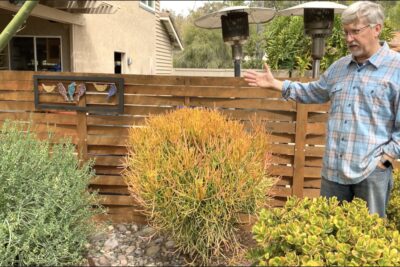
In the video Tim explains his bender-board screen
Surprisingly, Tim accesses it by driving over a verdant planted strip, alongside the driveway, that can handle being crushed.
Kurapia "lawn alternative"
Retired SDBG horticulturist Dave Ehrlinger recommended kurapia to the Jaras. It's a deep green ground cover with a dense growth habit, suitable for Zones 7b and above. Like better-known dymondia (see above), "You can walk on it, even drive on it," Tim says of the spreading nonsucculent mat from Japan.
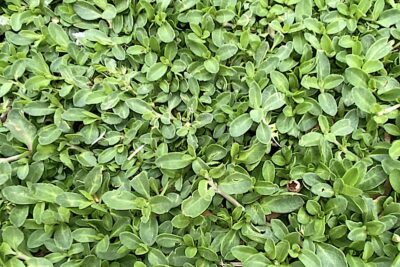
Kurapia ground cover serves as a low-water lawn substitute
When 72 plugs (a standard tray) are spaced 15-18 inches on center, they spread to cover about 100 square feet. During kurapia's main growth period, March through September, plugs take only three to four months to fill in.
Got a Question?
Do ask it in a comment below. I'd love to know what you think of the Jaras' succulent garden, and am happy to help. They have also graciously provided their emails, should you want to contact them:
- Pam: tpkajara@yahoo.com
- Tim: Timothy.jara@gmail.com
The post See a Seven-Room Succulent Garden I Love appeared first on Debra Lee Baldwin. Copyright © Debra Lee Baldwin.
from Debra Lee Baldwin https://ift.tt/QUjv6mV
via IFTTT

